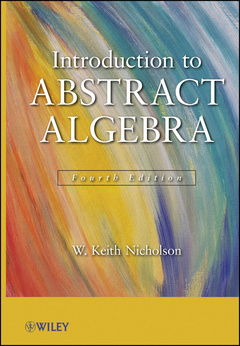Description
Introduction to Abstract Algebra (4th Ed.)
Author: Nicholson W. Keith
Language: English
Subject for Introduction to Abstract Algebra:
560 p. · 18x25.7 cm · Hardback
Description
/li>Contents
/li>Biography
/li>
Praise for the Third Edition
". . . an expository masterpiece of the highest didactic value that has gained additional attractivity through the various improvements . . ."?Zentralblatt MATH
The Fourth Edition of Introduction to Abstract Algebra continues to provide an accessible approach to the basic structures of abstract algebra: groups, rings, and fields. The book's unique presentation helps readers advance to abstract theory by presenting concrete examples of induction, number theory, integers modulo n, and permutations before the abstract structures are defined. Readers can immediately begin to perform computations using abstract concepts that are developed in greater detail later in the text.
The Fourth Edition features important concepts as well as specialized topics, including:
The treatment of nilpotent groups, including the Frattini and Fitting subgroups
Symmetric polynomials
The proof of the fundamental theorem of algebra using symmetric polynomials
The proof of Wedderburn's theorem on finite division rings
The proof of the Wedderburn-Artin theorem
Throughout the book, worked examples and real-world problems illustrate concepts and their applications, facilitating a complete understanding for readers regardless of their background in mathematics. A wealth of computational and theoretical exercises, ranging from basic to complex, allows readers to test their comprehension of the material. In addition, detailed historical notes and biographies of mathematicians provide context for and illuminate the discussion of key topics. A solutions manual is also available for readers who would like access to partial solutions to the book's exercises.
Introduction to Abstract Algebra, Fourth Edition is an excellent book for courses on the topic at the upper-undergraduate and beginning-graduate levels. The book also serves as a valuable reference and self-study tool for practitioners in the fields of engineering, computer science, and applied mathematics.
ACKNOWLEDGMENTS xvii
NOTATION USED IN THE TEXT xix
A SKETCH OF THE HISTORY OF ALGEBRA TO 1929 xxiii
0 Preliminaries 1
0.1 Proofs / 1
0.2 Sets / 5
0.3 Mappings / 9
0.4 Equivalences / 17
1 Integers and Permutations 23
1.1 Induction / 24
1.2 Divisors and Prime Factorization / 32
1.3 Integers Modulo n / 42
1.4 Permutations / 53
1.5 An Application to Cryptography / 67
2 Groups 69
2.1 Binary Operations / 70
2.2 Groups / 76
2.3 Subgroups / 86
2.4 Cyclic Groups and the Order of an Element / 90
2.5 Homomorphisms and Isomorphisms / 99
2.6 Cosets and Lagrange’s Theorem / 108
2.7 Groups of Motions and Symmetries / 117
2.8 Normal Subgroups / 122
2.9 Factor Groups / 131
2.10 The Isomorphism Theorem / 137
2.11 An Application to Binary Linear Codes / 143
3 Rings 159
3.1 Examples and Basic Properties / 160
3.2 Integral Domains and Fields / 171
3.3 Ideals and Factor Rings / 180
3.4 Homomorphisms / 189
3.5 Ordered Integral Domains / 199
4 Polynomials 202
4.1 Polynomials / 203
4.2 Factorization of Polynomials Over a Field / 214
4.3 Factor Rings of Polynomials Over a Field / 227
4.4 Partial Fractions / 236
4.5 Symmetric Polynomials / 239
4.6 Formal Construction of Polynomials / 248
5 Factorization in Integral Domains 251
5.1 Irreducibles and Unique Factorization / 252
5.2 Principal Ideal Domains / 264
6 Fields 274
6.1 Vector Spaces / 275
6.2 Algebraic Extensions / 283
6.3 Splitting Fields / 291
6.4 Finite Fields / 298
6.5 Geometric Constructions / 304
6.6 The Fundamental Theorem of Algebra / 308
6.7 An Application to Cyclic and BCH Codes / 310
7 Modules over Principal Ideal Domains 324
7.1 Modules / 324
7.2 Modules Over a PID / 335
8 p-Groups and the Sylow Theorems 349
8.1 Products and Factors / 350
8.2 Cauchy’s Theorem / 357
8.3 Group Actions / 364
8.4 The Sylow Theorems / 371
8.5 Semidirect Products / 379
8.6 An Application to Combinatorics / 382
9 Series of Subgroups 388
9.1 The Jordan–H¨older Theorem / 389
9.2 Solvable Groups / 395
9.3 Nilpotent Groups / 401
10 Galois Theory 412
10.1 Galois Groups and Separability / 413
10.2 The Main Theorem of Galois Theory / 422
10.3 Insolvability of Polynomials / 434
10.4 Cyclotomic Polynomials and Wedderburn’s Theorem / 442
11 Finiteness Conditions for Rings and Modules 447
11.1 Wedderburn’s Theorem / 448
11.2 The Wedderburn–Artin Theorem / 457
Appendices 471
Appendix A Complex Numbers / 471
Appendix B Matrix Algebra / 478
Appendix C Zorn’s Lemma / 486
Appendix D Proof of the Recursion Theorem / 490
BIBLIOGRAPHY 492
SELECTED ANSWERS 495
INDEX 523
W. KEITH NICHOLSON, PhD, is Professor in the Department of Mathematics and Statistics at the University of Calgary, Canada. He has published extensively in his areas of research interest, which include clean rings, morphic rings and modules, and quasi-morphic rings. Dr. Nicholson is the coauthor of Modern Algebra with Applications, Second Edition, also published by Wiley.




